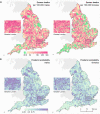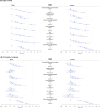Community factors and excess mortality in first wave of the COVID-19 pandemic in England
- PMID: 34145260
- PMCID: PMC8213785
- DOI: 10.1038/s41467-021-23935-x
Community factors and excess mortality in first wave of the COVID-19 pandemic in England
Abstract
Risk factors for increased risk of death from COVID-19 have been identified, but less is known on characteristics that make communities resilient or vulnerable to the mortality impacts of the pandemic. We applied a two-stage Bayesian spatial model to quantify inequalities in excess mortality in people aged 40 years and older at the community level during the first wave of the pandemic in England, March-May 2020 compared with 2015-2019. Here we show that communities with an increased risk of excess mortality had a high density of care homes, and/or high proportion of residents on income support, living in overcrowded homes and/or with a non-white ethnicity. We found no association between population density or air pollution and excess mortality. Effective and timely public health and healthcare measures that target the communities at greatest risk are urgently needed to avoid further widening of inequalities in mortality patterns as the pandemic progresses.
Conflict of interest statement
The authors declare no competing interests.
Figures




References
-
- Office for National Statistics. Analysis of All-cause Mortality Patterns of Selected European Countries and Regions, Week Ending 3 January (Week 1) to Week Ending 12 June (Week 24) 2020. (Office for National Statistics, 2020).
-
- Office for National Statistics. Deaths Involving COVID-19 by Local Area and Socioeconomic Deprivation: Deaths Occurring Between 1 March and 31 July 2020. (Office for National Statistics, 2020).
Publication types
MeSH terms
Grants and funding
LinkOut - more resources
Full Text Sources
Medical

